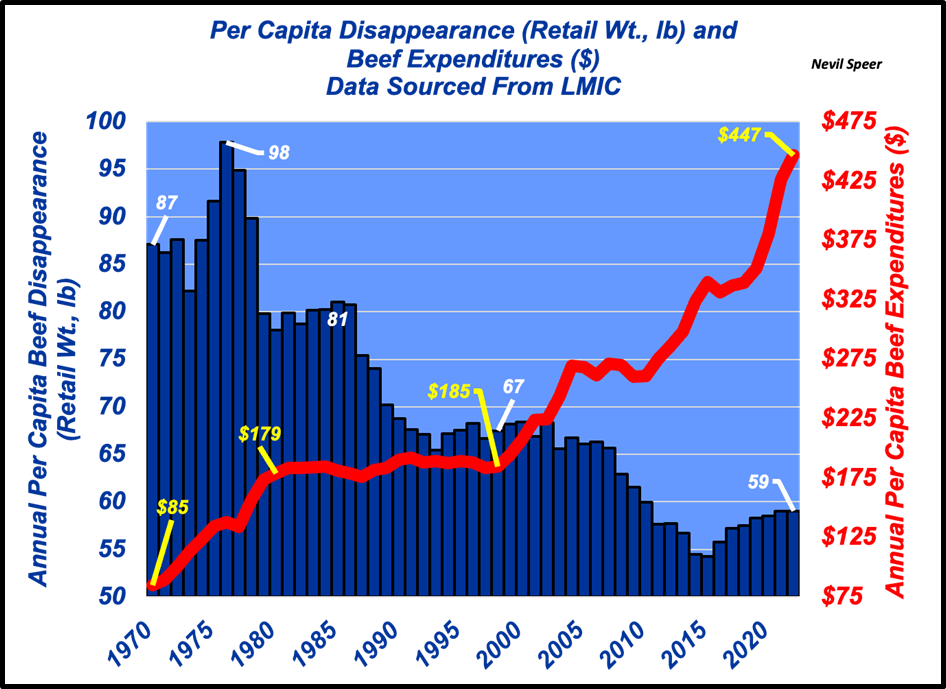Speer: The OFF Boondoggle

OFF: Supporters of the OFF Act (Opportunities for Fairness in Farming) have been citing consumption data as evidence of the Checkoff’s supposed ineffectiveness. For example, FreedomWorks and OCM recently provided this statement:
…beef was consumed at an average of 84.4 pounds per person per year in 1970, and in 2023, that number is expected to be 56.7 pounds per person. In contrast, chicken consumption is up from 40.1 pounds in 1970 to an estimated 101.9 pounds projected for 2023 — all without the help of USDA commodity checkoff programs — quasi-governmental slush funds that hamper competing sectors.
Let’s set aside the “quasi-governmental slush fund” distortion; that’s another column for another time. What matters here is the basis of the argument.
“Consumption”: First, there’s no real measurement of beef consumption. The more appropriate description being “disappearance.” And it’s simply a derivation of math: total supply divided by U.S. population.
Consequently, “consumption” is essentially an arithmetical artifact and provides zero insight into what consumers think of the product and their respective price / value appraisal when making purchasing decisions. It’s “what demand is not” (more below).
“Consumption” vs. Spending: The first graph collectively represents beef disappearance (“consumption”) and spending since 1970. A couple of items are of key importance:
- If “consumption” is the measure of choice, it declined 17 lb in just 9 years preceding passage of the check off in ’85.
- Since the Checkoff, “consumption” has declined only 22 lb over the subsequent span of nearly forty years.
- Never mind consumption, what really matters is spending! Note that between 1980 and 1998 beef spending was essentially flat. Considering inflation during the period, consumer spending actually went backwards. In other words, the beef industry was essentially forced to increasingly discount its product to clear decreasing volume over time.
- However, since 1998, per capita spending has surged $260 – gaining ~3.75% on an annualized basis.

Demand: All that brings us to demand. The Checkoff was implemented as a “national marketing and research program designed to increase the demand for beef at home and abroad.” And to that end, it’s proven incredibly successful.
For example, the second graph details the recent quantity / price relationship – i.e. demand (NOT disappearance) - in five-year increments. Over time, the data points are moving up-and-to-the-right: beef demand is improving! The past three years have been especially favorable. (As a side note, the data rebuffs any argument that beef demand was bolstered by COOL.)

Boondoggle: Let’s return to Dr. Wayne Purcell – industry expert featured in the previous two columns (see: More Questions Than Answers and Free Market It Is!) His most important work revolved around beef demand. One reader, responding to the previous columns, crediting Dr. Purcell this way: “He challenged industry to focus on demand (by identifying the demand drivers) and the consumer. He and the first industry Long Range Planning Task Force helped save the industry.”
Purcell authored a 1998 paper entitled, A Primer on Beef Demand. The premise being, “failure to understand demand is getting in the way of progressive efforts to halt the 20-year slide in market share for beef.”
Most pertinent to this discussion and the OFF logic described above, one section of his paper is entitled, “The Per-Capita Consumption Boondoggle, or What Demand is Not.” Purcell explains that:
To most cattlemen and even to some professionals who write about the beef business-and who ought to know better-per-capita consumption is seen as synonymous with demand. Nothing could be further from the truth. Making this mistake can lead you down all the wrong roads.
Precisely right! And OFF supporters, in their effort to undermine the Checkoff, are touting a meaningless measure – and in turn boondoggle their own credibility.
Nevil Speer is an independent consultant based in Bowling Green, KY. The views and opinions expressed herein do not reflect, nor are associated with in any manner, any client or business relationship. He can be reached at nevil.speer@turkeytrack.biz.







